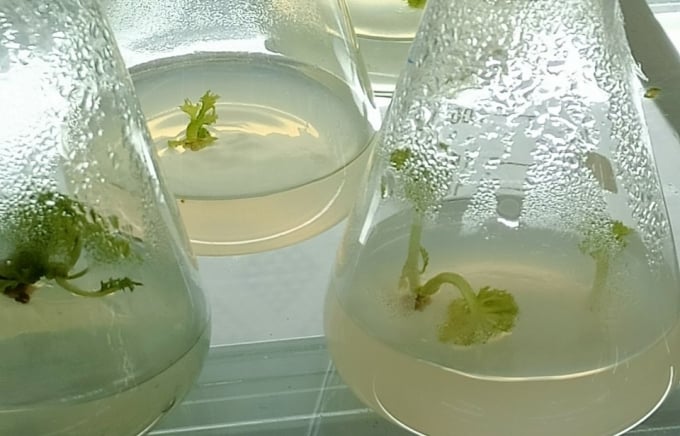November 27, 2025 | 04:46 GMT +7
November 27, 2025 | 04:46 GMT +7
Hotline: 0913.378.918
November 27, 2025 | 04:46 GMT +7
Hotline: 0913.378.918

The Ngoc Linh Ginseng with the scientific name of Panax Vietnamensis, is a rare herbal with the highest content of Saponin compared to other breeds of ginseng around the world.
According to the Department of Research and International Affairs (Hoang Lien National Park), the implementation of plant cell tissue culture technology is a new development direction of the contemporary agriculture industry. Recently, cadres working for the department have implemented a breeding model of Ngoc Linh Ginseng utilizing traditional methods through sowing seeds and the use of plant cell tissue culture technique accompanied by the latest technology.
The goal is to produce an excellent, high quality breed of the plant, and achieve high efficiency in the effort of preservation and development of rare genes in Sa Pa. There are also purposes to supply this breed to ethnic minorities living in the core area and the buffer zone of Hoang Lien National Park, contribute to the creation of jobs and reduce the pressure of doing harm to the forest in exchange to make a living.
The Ngoc Linh Ginseng with the scientific name of Panax Vietnamensis, is a rare herbal with the highest content of Saponin compared to other breeds of ginseng around the world. This special ginseng is categorized as a superior, high economic value plant. Ngoc Linh Ginseng specializes in improving health, extending lifetime, and preventing diseases.
Translated by Hoang Duy
/2025/11/26/4909-2-154329_878.jpg)
(VAN) Pearl grouper farming in HDPE cages not only delivers economic efficiency but also contributes to protecting the environment, creating jobs, and promoting marine-based experiential tourism.

(VAN) The model of making a living under the forest canopy through the agroforestry system in Van Son commune, Bac Ninh province, is expected to generate an annual income of approximately VND 30 million/ha.

(VAN) Many enterprises in Can Tho are harnessing natural energy and reducing greenhouse gas emissions in their production processes, thereby contributing to the promotion of a sustainable green transition.
/2025/11/24/3536-2-112800_176.jpg)
(VAN) Dong Nai now has tens of thousands of hectares of forests certified for sustainable management, and this area will continue to be expanded in the coming period.

(VAN) Vinh Ha hamlet (Dai Xuyen commune, Hanoi) is shifting away from small-scale farming as households adopt bioscurity into their breeder chicken models.

(VAN) Heavy rains make aquatic species more vulnerable to disease. Proactive water management and high-tech systems help farmers prevent outbreaks and protect yields.

(VAN) Greenhouses are shifting production mindsets in Binh Lu commune, enabling farmers to ‘weather the sun and rain’ and secure stable vegetable harvests throughout the year.